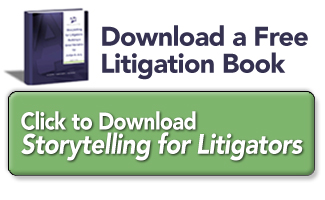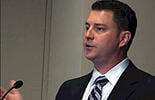by Ryan H. Flax, Esq.
In our most recent post, we discussed how important it is to use an opening statement to make jurors like you as a person and thus embrace your client’s case. Another key theme of opening statements is storytelling. Everyone is always advising lawyers to use storytelling to be more persuasive. So, why isn’t it happening more?
Maybe no one is reading these publications. Or perhaps when preparing for trial, we’re mired in details and chronology.
In law school, we’re taught how to deal with this Venn diagram involving the intersection of the law and the facts.
Never are we taught that the real intersection we care about involves human beings, how they think, how they learn, and how their influenced.
Studies and countless mock jury exercises show us that deliberating jurors discuss the case as a story – a complete story with a beginning, middle and end and a whole set of characters. If this is so, whose story do we want the jury using: ours, opposing counsel’s, or some completely novel concoction of their own making?
Don’t be a slave to chronology. The natural tendency is to tell it exactly as it happened in chronological order. The problem is that this isn’t interesting, and, as we know, the theory of primacy means that the important stuff must be said first even if it didn’t happen first.
Your story must have structure. Give your story a logical beginning (where did your client start out?), middle (where did the relationship between your client and the opposing party begin?), climax (why are we really here?), and ending (“so here we are in the courtroom”), but don’t just place the events in the order in which they occurred. Which ones matter? Which ones convey the emotion and theme of your case? Sort out these questions to distill your case into a terse and interesting story.
Have a theme, tell a story. Give your jurors a reason to listen to you. Keep them interested.
Why use storytelling? Let’s briefly go through the science.
FMRI scanning studies at Princeton University have shown that good storytelling causes the brains of the listeners and the storytellers to sync up in terms of the parts that are most active and when.1 So the saying “we’re on the same wavelength” can be literally true. In such cases, the listener’s brains act more like participants in the story than observers of the action – they become psychologically and emotionally invested, which is what we want.
When telling a story, it is essential to use sensory language. Paint a picture of the scene and the characters.2 Simply using words and argument without sensory language is interpreted by jurors as noise and is not interesting. Sensory language activates the whole brain and does so in the areas related to the senses (sight, taste, movement, etc.).3
Stories also do for jurors what they need to be good jurors. Stories interrupt daydreaming, organize information, and make the case more interesting.
When organizing your story, remember these five rules of thumb: The simpler the story, the better. The simpler the language you use, the better. Using metaphors and analogies is essential. You must distill your facts to make the story relatable. You must use sensory language and word pictures.
Star Wars, The Godfather, Harry Potter are all movies with strong stories and strong themes. Can you represent either side of the controversies in these “cases” and craft an opening line for your opening statement story for each? Here's an example of how you might approach each. Can you tell which side is which?
|
Star Wars |
|
|
Good men must meet evil with resistance. Against overwhelming odds and a seemingly insurmountable force, our band of rebels has bravely fought for freedom for all the citizens of the galaxy. |
We have here a group of terrorists. Terrorists that want to see chaos reign across the galaxy and that will stop at nothing, not even the murder of hundreds of thousands of our brave military, to see the fall of our government. |
|
The Godfather |
|
|
Murder. Robbery. Extortion. The Corleone crime syndicate has cost the people of this State billions of dollars and has cost countless lives. This is the story of these crimes. |
This is the story of a man forced into dire circumstances. He has fought to keep his family together, to protect them against powerful enemies, to protect their lives. |
|
Harry Potter |
|
|
Orphaned and then mistreated for 11 years, Mr. Potter has risen above his upbringing to fight for the lives and the freedom of his friends and even those who call themselves his enemies. |
His offer of friendship rejected, Mr. Malfoy was made to look the fool time and time again by Mr. Potter. In the end, Mr. Potter intentionally destroyed Mr. Malfoy’s entire way of life. |
Don’t be a lawyer who chokes the humanity out of a story by reducing it to its legal essentials.4 Don’t turn a story about broken promises into a breach of contract lawsuit. Don’t turn a story about the tragic death of a loving wife into a survivor seeking damages for wrongful death. Don’t turn the defendant’s laying waste to acres of pristine woodlands into an environmental contamination and remediation case. Jurors live in the real world, so relate your case to that world.
Other articles and resources related to opening statements, storytelling and persuasion from A2L Consulting:
- 5 Ways to Maximize Persuasion During Opening Statements - Part 1
- Don't Be Just Another Timeline Trial Lawyer
- Free E-Book: Storytelling for Litigators E-Book 3rd Ed.
- Free Webinar: Storytelling as a Persuasion Tool
- Complimentary Subscription: This Blog! The Litigation Consulting Report
- Why The Use of Clichés Puts Your Persuasiveness at Risk
- How to Apply Cialdini's 6 Principles of Persuasion in the Courtroom
- Top 14 Litigation Consulting and Persuasion-Focused Articles of 2014
- How I Used Litigation Graphics as a Litigator and How You Could Too
- 14 Differences Between a Theme and a Story in Litigation
- Storytelling Proven to be Scientifically More Persuasive
- 10 Things Every Mock Jury Ever Has Said
[1] Stephens et al., Speaker-Listener Neural Coupling Underlies Successful Communication, PNAS vol. 107, No. 32 14425-30 (August 10, 2010).
[2] Gerald R. Powell, Opening Statements: The Art of Storytelling, 31 Stetson L.Rev. 89, at 96-97 (2001).
[3] See, e.g., Gonzalez et al., Reading Cinnamon Activates Olfactory Brain Regions, NeuroImage 32 (2006) 906-12.
[4] Gerald R. Powell, Opening Statements: The Art of Storytelling, 31 Stetson L.Rev. 89, at 92 (2001).








Leave a Comment